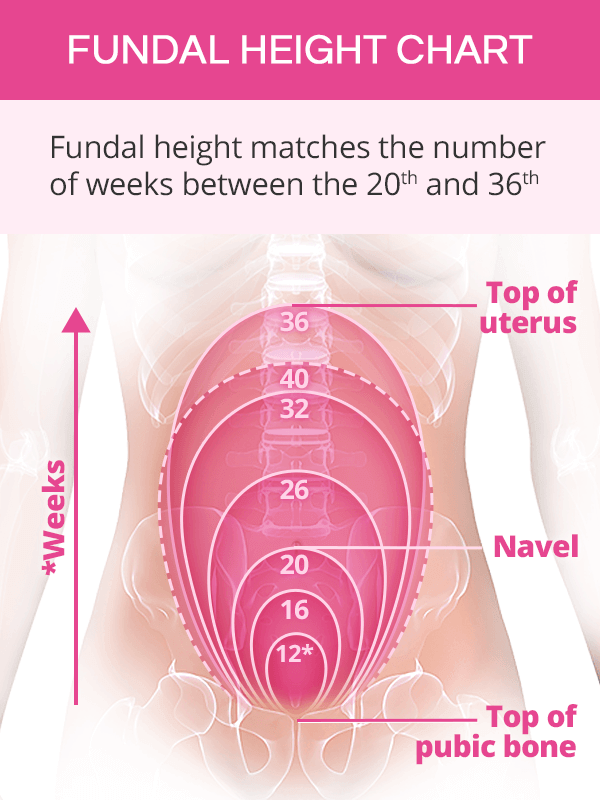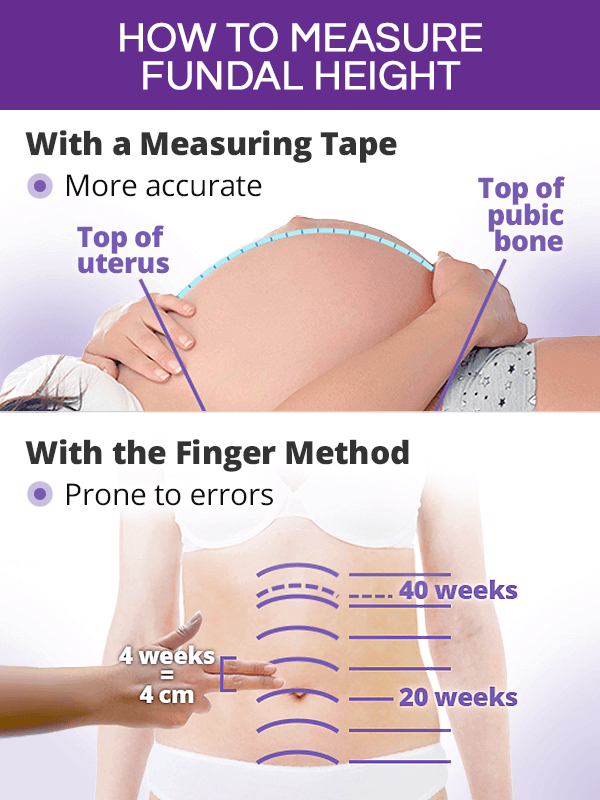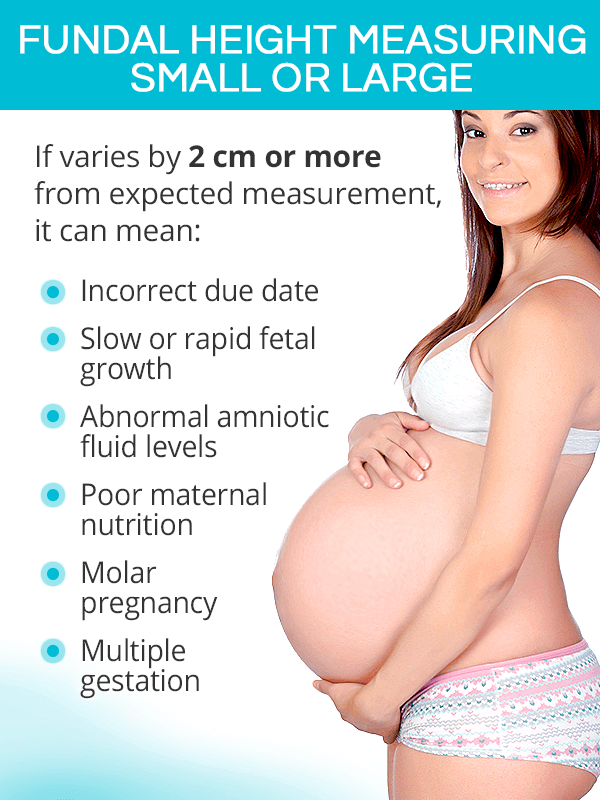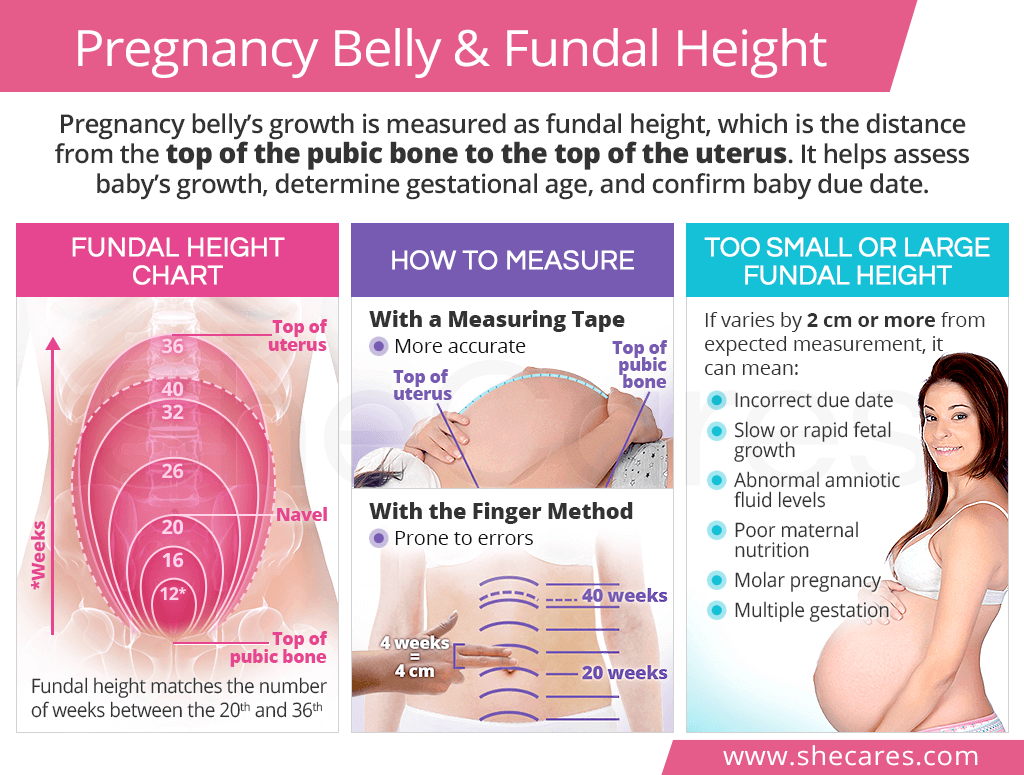What Is Fundal Height?
Fundal height, also known as McDonald's Rule, is a measurement of the size of the uterus during pregnancy. It is measured in centimeters as the distance from the top of the pubic bone (specifically, a joint called symphysis pubic) to the top of the uterus (called fundus). As such, it is properly called a symphysis pubis fundal height (SFH).
Starting at the second trimester, fundal height measurement is typically recorded at most prenatal visits for the following purposes:
- Assessing baby's growth and development
- Determining gestational age
- Confirming baby due date
Normal Fundal Height

As the pregnancy progresses, the uterus expands in the abdomen with its top moving up by about 4 centimeters per month, an equivalent of two finger-widths.
After the 20th week and until the 36th week of pregnancy, the fundal height measurement usually matches the number of weeks of pregnancy. This means that for a woman at the 26th week of pregnancy, the fundal height measurement should be about 26 cm (give or take 2 cm).
Across various pregnancy stages, fundal height measurement landmarks are expected to be as follows:
- Weeks 12-14: top of uterus is right above pubic bone level
- Weeks 20-22: top of uterus is at the level of belly button (navel)
- Weeks 36-40: top of uterus is right under the ribs
- Weeks 36-40: as baby drops lower into the pelvis, top of uterus regresses by about 4 cm to the 36-32cm level 1
How To Measure Fundal Height
Fundal height measurement should be taken on an empty bladder with a woman lying flat on her back with a pillow under the head and shoulders. Care should be taken so that the mother does not become hypotensive in such position.
There are two methods of measuring fundal height, by using a measuring tape or by hand:
How to Measure Fundal Height with a Measuring Tape

Using a measurement tape to estimate fundal height is the most accurate method of the two. It is typically done by a doctor during prenatal visits, although it can also be done at home on one's own pregnancy belly:
Locate the top of the pubic bone by hand (it is right above the pubic hair line).
Locate the top of the uterus by hand (it will feel like a firm ball).
Place the beginning of a measuring tape at the top of the uterus.
Bring the tape down until the top of the pubic bone.
Record the distance between the two points as fundal height.
How to Measure Fundal Height with the Finger Method
Fundal height can also be measured by hand. However, because the results might vary depending on the thickness of one's fingers and a woman's body shape, it is not the preferred method. Nevertheless, the following are the steps to take the fundal height by hand:
Locate the top of the uterus by hand.
Count by how many finger-widths is the top of the uterus located below or above the belly button. Keep in mind that two finger widths represent one month, or four weeks.
Remembering that the uterus should be at belly button level at 20-22 weeks, add (if top of uterus is above belly button) or subtract (if top of uterus is below belly button) the number of weeks from the previous step.
Record the resulting number as fundal height.
Fundal Height Measuring Small or Large

A slightly smaller or larger fundal height does not necessarily mean that the baby is not developing properly.
However, a significant discrepancy of 2 cm and more in fundal height measurements could mean an incorrectly estimated due date or potential signs of complications that should be promptly addressed, including the following: 2
- Slow fetal growth
- Rapid fetal growth
- Too little or too much amniotic fluid
- Poor maternal nutrition
- Multiple gestation
- Molar pregnancy
It is important to keep in mind that certain factors, such as obesity, gestational diabetes, or uterine fibroids, might affect fundal height accuracy. Taking the measurements with a full bladder can also give inaccurate results up to 2-3 cm.
Key Takeaways
Fundal height measurement is an important tool in providing quality prenatal care. Defined as the distance between the top of the pubic bone and the top of the uterus, it is a measure of uterine growth to monitor baby's development, estimate gestational age, and confirm due date. There are two methods of measuring fundal height: by using a measuring tape (more accurate, preferred) and by using the finger method (less accurate, prone to errors). Recording the size of pregnancy belly is typically done at every doctor's visit starting in the second trimester, which allows prompt detection of potential abnormalities, such as a fundal height measuring small or large. If the discrepancy is larger than 2 cm, it can be a sign of potential complications that necessitate further evaluations with a pregnancy ultrasound or other prenatal tests.
Sources
- Australian and New Zealand Journal of Obstetrics and Gynecology. (2012). Serial plotting on customized fundal height chart results in doubling of the antenatal detection of small for gestation age fetuses in nulliparous women. Retrieved August 12, 2019 from https://www.perinatal.org.uk/gap/Resources/Alphonse_Roex_Antenatal_detection_SGA_Serial_Plotting_Cust_Chart_ANZJOG%202012.pdf
- BMJ. (2016). International Standards for symphysis-fundal height based on serial measurements from the Fetal Growth Longitudinal Study of the INTERGROWTH-21st Project: prospective cohort study in eight countries. Retrieved August 12, 2019 from https://www.ncbi.nlm.nih.gov/pmc/articles/PMC5098415/
- Cochrane Database of Systematic Reviews. (2015). Symphysial fundal height (SFH) measurement in pregnancy for detecting abnormal fetal growth. Retrieved August 12, 2019 from https://www.cochranelibrary.com/cdsr/doi/10.1002/14651858.CD008136.pub3/full
- ISRN Obstetrics and Gynecology. (2013). Fundal Height Growth Curve for Thai Women. Retrieved August 12, 2019 from https://www.ncbi.nlm.nih.gov/pmc/articles/PMC3649359/
- Journal of The Royal Society Interface. (2011). Estimation of gestation age from fundal height: A solution for resource-poor settings. Retrieved August 12, 2019 from https://www.researchgate.net/publication/51578682_Estimation_of_gestational_age_from_fundal_height_A_solution_for_resource-poor_settings
- King Edward Memorial Hospital. (2016). Fundal height: Measuring with a Tape Measure. Retrieved August 12, 2019 from https://www.kemh.health.wa.gov.au/~/media/Files/Hospitals/WNHS/For%20health%20professionals/Clinical%20guidelines/OG/WNHS.OG.FundalHeightMeasuringwithaTapeMeasure.pdf
- Perinatal Institute. (n.d.). Fundal Height (Fundal Height Measurement and Plotting). Retrieved August 12, 2019 from http://www.perinatal.org.uk/FetalGrowth/B.aspx
- Revista de Saúde Pública. (2009). Symphysis-fundal height curve in the diagnosis of fetal growth deviations. Retrieved August 12, 2019 from https://www.scielosp.org/article/ssm/content/raw/?resource_ssm_path=/media/assets/rsp/v44n6/1674.pdf
Footnotes:
- The Open University. (n.d.). Antenatal Care Module: 10. Estimating Gestational Age from Fundal Eight Measurement. Retrieved August 12, 2019 from https://www.open.edu/openlearncreate/mod/oucontent/view.php?id=40&printable=1
- Mayo Clinic. (2017). What's the significance of a fundal height measurement? Retrieved August 12, 2019 from https://www.mayoclinic.org/healthy-lifestyle/pregnancy-week-by-week/expert-answers/fundal-height/faq-20057962
